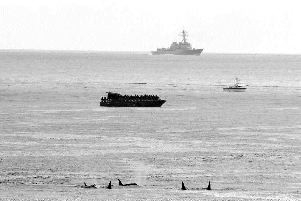|
Orcas circle in Haro Strait near Victoria with a whale-watching boat and U.S. navy destroyer further offshore.
The U.S. navy is reviewing an incident in which a pod of endangered killers whales began behaving strangely when a nearby destroyer blasted powerful sound waves into waters off Victoria.
"It is sort of a worst-nightmare scenario," said Dan Kukat, president of the Whale Watch Operators Association. He met Tuesday with Fisheries and Oceans Canada officials to file a complaint over the use of sonar.
The sonar blasts, which could be heard above water, are also being blamed for unusual behaviour in porpoises and a minke whale.
The incident took place Monday in Haro Strait, which separates San Juan Island from southern Vancouver Island.
Worries about the impact of sonar on whales, who rely on underwater sound for navigation, finding food and communication, is a growing issue in the wake of strandings in various parts of the world.
Worry about sonar tops the agenda for Lance Barrett-Lennard, senior marine mammal scientist at the Vancouver Aquarium Marine Science Centre. "In terms of an immediate new and very dangerous issue, it is front and foremost."
The question, said Anna Hall, who leads whale-watching tours for Victoria's Prince of Whales, is whether humans want to have an environment that's good for whales. "Everyone has to co-operate and participate or there's really not much point."
The Whale Watch Operators Association has a lengthy set of rules governing behaviour of member whale-watching companies in the U.S. and Canada to minimize impact on whales.
"We are very concerned about it and are looking into it from every aspect," including environmental, said Karen Sellers, a public affairs officer with the U.S. navy in Seattle. She could not immediately say what type of sonar the USS Shoup was using or why it was used.
John Ford, marine mammal scientist with Fisheries and Oceans Canada, said it is difficult to assess the impact of the sonar used by the USS Shoup, but there is definitely cause for concern.
Different types of sonar can affect whales differently. Studies indicate that low-frequency active sonar can cause strandings.
The USS Shoup, an Arleigh Burke- class destroyer, turned off its sonar when contacted by the Canadian Coast Guard. The warship was on its way to the Canadian Forces Maritime Experimental Test Range at Nanoose Bay.
Ken Balcomb, head of the Center for Whale Research at Friday Harbor in Washington State, was watching the J pod, part of the endangered southern resident population of 84 animals, on Monday afternoon. He heard the sonar on hydrophones, which pick up underwater sounds. "They got into a tight group and hugged closely along the shore."
The pod of about 20 then split up and the whales changed direction a number of times and appeared to be stressed, he said.
"They were very undecided-looking and somewhat agitated in their behaviour. The Minke whale we saw at the same time was just streaking away from here."
Porpoises raced through the water away from the sound, he said.
So far, no whales or porpoises have been reported stranded, but that remains a possibility, Balcomb said Tuesday. He described the sonar sound as "intense."
It could possibly "deafen or damage some of the individuals, especially the young ones," he said. J pod has two new calves, a cause for celebration among whale advocates.
Balcomb is attending a workshop today with the U.S. National Marine Fisheries Service in Seattle to discuss the impact of vessel noise and interference on whales. The USS Shoup incident will be on the table. "This is the clearest example of any that I have ever seen."
Anna Hall said the sonar was so loud she could hear it without hydrophones.
Hall took tours out twice Monday. After hydrophones were put in the water off the west side of San Juan Island late morning, she heard a high-pitched, pulsing "boing" sound coming about 60 seconds apart. The second trip mid-day in the same area found killer whales bunched close to shore, changing direction as Balcomb described.
That time, the sounds were louder and repeated more frequently. They increased as the U.S. warship came closer and stopped when it passed by, she said.
"It was extremely bothersome. I can not imagine what it was like in the water."
There are no rules governing the use of sonar in that area, Canadian navy spokesman Gerry Pash said. The practice at the Nanoose range is to turn off sonar when marine mammals are present.
Sonar is used to detect underwater objects by sending out pulses of sound.
Top
|
